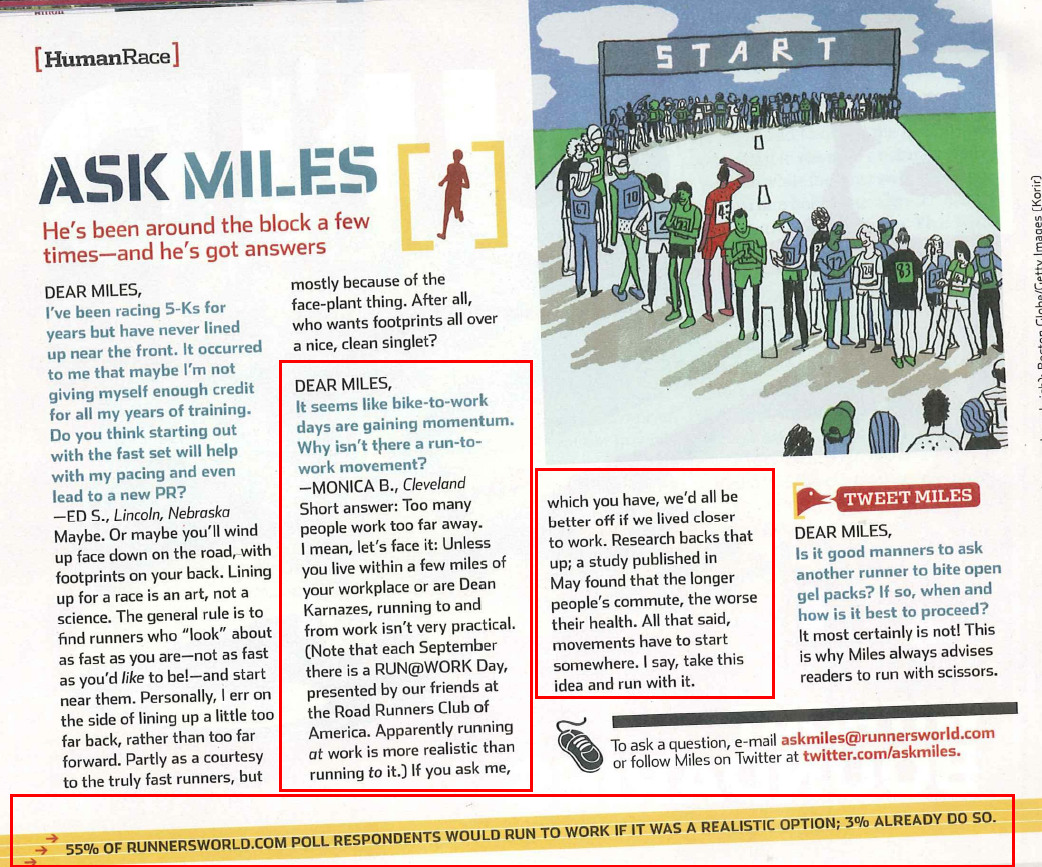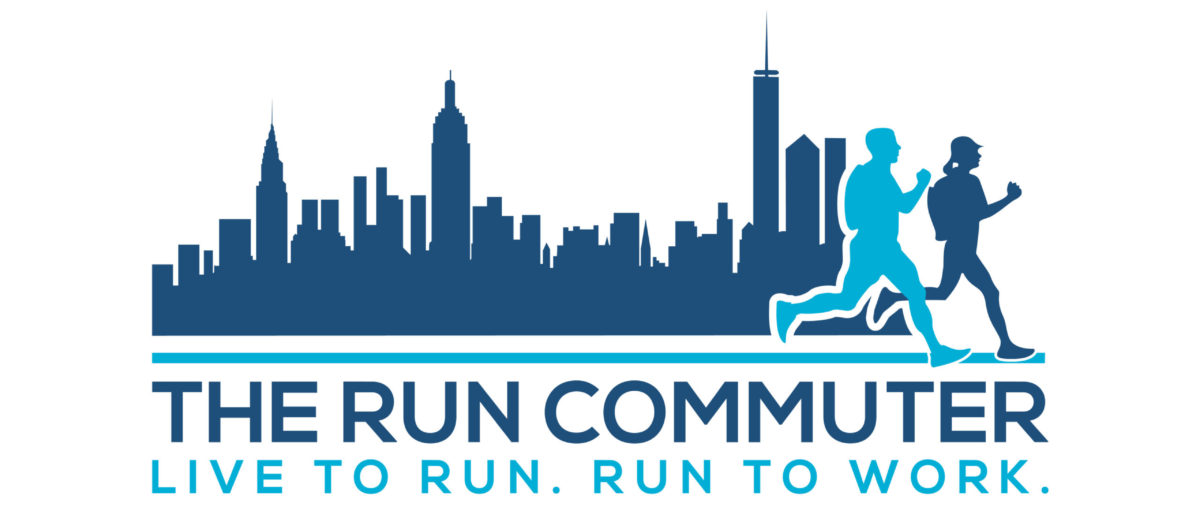Did anyone see this question in the latest edition of Runner’s World?
[fusion_builder_container hundred_percent=”yes” overflow=”visible”][fusion_builder_row][fusion_builder_column type=”1_1″ background_position=”left top” background_color=”” border_size=”” border_color=”” border_style=”solid” spacing=”yes” background_image=”” background_repeat=”no-repeat” padding=”” margin_top=”0px” margin_bottom=”0px” class=”” id=”” animation_type=”” animation_speed=”0.3″ animation_direction=”left” hide_on_mobile=”no” center_content=”no” min_height=”none”]
We were asked whether we thought run commuting was a movement earlier this year during the WalkJogRun interview (though it was later edited out). I said that I didn’t think so. But since then, it really does seem like it has been taking off.
We’ve heard from some readers who have been running to work for years, some who just started last week, and others who have started running to work with their friends/coworkers. Many of you are current or former bike commuters. Some are run commuting to train for marathons and ultramarathons. All of you are runners…
I want run commuting to be a movement. I want it to gain momentum and, drawing from Runner’s World poll question, become a “realistic option” for getting to and from work. Where do we start?
1. Run commute as often as you can
When we’re run commuting, we are visible to other commuters out on the streets, whether they are drivers stuck in traffic, cyclists, walkers, or public transit riders. By being seen regularly (especially while wearing a backpack), people begin to accept the notion that run commuting is realistic. People can do it. And that’s key – creating a new thought in another’s mind that says ‘run commuting is possible and people do it.’ Hell, it wasn’t too long ago when marathons were seen as something only elite runners could complete. Now everyone is knocking them out.
2. Talk to others about run commuting
If you’ve run commuted before, you should already be familiar with this scenario.
You stop running near your office to cool down on your way in. Another worker in your building sees you and comes over to chat. They ask if you just ran to work, you say “yes”, and then they say something along the lines of:
“You’re crazy!”
“That’s amazing!”
“I would love to try run commuting, but I live too far away.”
“I absolutely could not do that without a shower.”
Use that conversation as a chance to promote run commuting. Show them that there are ways to try it for themselves even if they live far away (multimodal run commute). Ask them if they’re training for any upcoming races. Tell them how running to work allows you to combine your commute and workout that were previously separate and time-consuming tasks. If run commuting helped with your race times, let them know. Mention that if a shower is keeping them from doing it, that they can try just running home from work. You don’t have to run both ways, everyday, afterall. Another important message to get across: you don’t need to have a bunch of fancy gear – almost any old backpack and clothes will do, though some things are nice to have (See Run Commuting Essentials.)
3. Become an advocate
There are many things that can be done at various public and private levels to promote not only run commuting, but other alternative commuting , as well.
Private Sector: How about trying to get your boss or building manager to put in a shower? Or some lockers in or near the bathrooms? These will benefit bike commuters, too! Rally everyone together and see what you can accomplish.
Public Sector: Run commuters are pedestrians, and sidewalk maintenance is always an issue. Make your voice heard and keep the way clear and safe; not only for you, but for children, walkers, and wheelchairs, too. Check out this post for more info. Even little things like broken streetlights and non-working pedestrian crosswalk signals go unnoticed for long periods of time. Contact the appropriate person or office to get it fixed.
Keep an eye out for alternative transportation-friendly legislation. Maybe there is a vote on a local greenway trail that for which you can grow a support base. Perhaps a new bridge is going to be built in order to ease major traffic congestion. Go to public meetings and ensure that the plan allows for safe passage of pedestrians. If it doesn’t, lobby to get it added. Remember: those things need to be accomplished during the planning process – not after they have started construction.
Write letters to your local paper in response to, or about, anything that is relevant to run commuting – traffic congestion, air quality, sidewalks, road building, health issues, running articles, etc. The more we publicly talk about it, the more the movement can grow.
Running Sector: Does your local run club have a newsletter? Ask if you can write an article for it. Turn some of those club runners in to run commuters! Become a run commuter buddy. Encourage a coworker to try and then run with them.
Don’t forget, you can always write about run commuting on our site. Bounce your ideas off us.
The Run Commuter tabled our first event last May. We also threw together an impromptu marathon-for-one. Got an idea for a local event that you can combine with passing out info and answering questions? Contact us! We’ve put together a handout that is available for anyone, and we can help you brainstorm your idea.
Finally, join the Run to Work Day group on Facebook and help plan the 2013 Run to Work Day with over 700 other members. Last year’s event had nearly 1000 participants!
Yes, this is a movement, run commuters. It’s our movement. Let’s make it happen![/fusion_builder_column][/fusion_builder_row][/fusion_builder_container]


As a brand new run commuter I’ve really enjoyed myself, especially after I got a pack more suited to the job. I was already bike commuting some days (and still do) so I had a good route plotted already and most people weren’t too surprised to hear about my new commute. In fact, many people I talk to are actually jealous I’m able to run commute at all. Distance and time are the biggest barriers for most people I talk to; commuting by bike doesn’t take much longer, if at all, than driving when you consider Atlanta traffic. Running, even for those who are pretty fit and fast, takes a consdierably larger chunk of time, in my opinion. This is also highly dependent on how far you are from your work. I’m training for a marathon and needed to find the time to fit in all the extra miles; using the extra time on my commute is a much more efficient use of my time over the whole day. The other added benefit I’ve noticed, in comparison to cycing (which I still love) and driving to work, is that I can actually zone out a bit on my run and think about my day ahead, what I need to do, who I need to call, errands, etc. with less fear of crashing. I still need to watch my step on the treachorous Atlanta sidewalks and streets but it’s much less mentally exhausting than riding into work. I think these are all factors one can use to talk up run commuting.
Great points and thanks for sharing, Jessica! Run commuting (and bike commuting for that matter) is definitely more appealing to people when the distance is shorter than 5 or 6 miles. I think the Runner’s World columnist makes a great and important point, when he/she says, “…we’d all be better off if we lived closer to work.”
I’d be interested to hear if you are following a traditional training plan for your marathon and, if so, whether you incorporate different types of workouts (speed, LSD runs) into your run commute. I’m part way through writing a post about race training for the run commuter. :o)
How can you only run home from work and expect to get there the next day?
Hi AJ, there are a couple of ways – Each morning you could carpool/hitch a ride, or take transit to work, leaving you free each afternoon to run home. Of course, it only will work in some people’s situations. But a lot of run commuters don’t run both ways every day. For example, some runners will take the train or bus into work twice a week, so they can run home afterwards.
Josh, I’m using a traditional marathon training plan in that I’m training with the Atlanta Marathon training program through the Atlanta Track Club (although I’m actually running NYC instead of Atlanta). We do the long runs as a group on Saturdays and I’ve followed those to the t. The plan includes short runs during the week and I’ve followed those as best as possible. I’m not always able to complete a run on the specific day called for in the plan but I aim to complete the prescribed weekly total mileage and the number of days with a running workout. Running to work fits nicely in to that plan and I’ve found that spreading a longer workout into 2 shorter distances (to and from work) it acts as a sort of speed workout, so I’m increasing overal endurance AND speed.
There are definitely more taking part in London that for sure! Whilst the price of petrol continues to rise, traffic worsens and people become aware of obesity, then lets hope it’ll truly take off. It’s got some way to go before catching up with cycle commuting, but progress is being made. Keep up the good work!
I’ve been training for a 100 miler, and the only way I could find the time to fit in the miles, was to run to and from work. Both ways is 25 miles total, so I don’t do it every day, usually twice a week, but some times 3. Some people in my office are curious, most are incredulous, but a few are offended. I don’t usually let what some people think get to me, but still I try not to ruffle too many feathers (it is my lively hood after all). I think that is an important part of making the run commute more accepted.
Now, I always bring fresh clothes for the way home. I don’t let them air dry and keep them out of site (socks especially). Before I leave in the morning, I take a shower and cleanup as usual. Then after I get to work, I might step into the bathroom and wipe down with cleansing wipes (Amazon has a Subscribe and Save on some), in addition to some body spray. Over the last couple months, I’ve learned it’s more art than science… just try packing all the stuff you need for the day to survive 12 miles, it’s not always obvious how to carry certain things (I once carried a George Foreman grill in my backpack).
Probably the biggest move I’ve made is to cut my hair shorter than I usually wear it, making it easier to fix. Before I did that, I would get comments like I “must of had a late night” or something. I’m not trying to hide what I do, but at the same time, I have to maintain a good balance in life and not let my running invade, and potentially harm, my job. It’s like doing early morning runs to preserve family time.